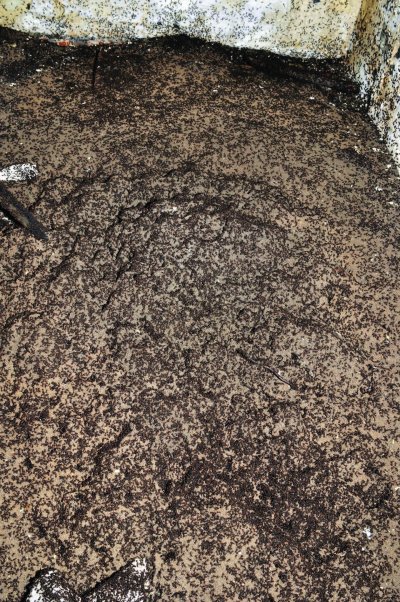A "colony" of up to one million cannibal ants trapped in a nuclear bunker for years have escaped, scientists in Poland have said.
The ants, which had no food source other than their dead nestmates, were first discovered in 2013 were found to be solely made up of worker ants meaning they could not reproduce—how their numbers grew so large was a mystery.
In a study published in the Journal of Hymenoptera Research, researchers have now studied the colony to understand how it functioned—and installed an escape route to see if its members would leave their home given the option.
The team, led by Wojciech Czechowski, from the Museum and Institute of Zoology and the Polish Academy of Sciences, were carrying out a survey of bats living in an abandoned Soviet nuclear bunker when they came across the wood ants living in an ammunition bunker where nuclear weapons were once kept. The ants had no access to the outside world and appeared to have come from a nest above that was positioned over a ventilation pipe. When the ants fell down the pipe, they were entombed in the bunker.

However, after returning to the site two years later, scientists found the colony was not only still there, but that it had grown in numbers. This was despite there being no obvious food source, no heat and no light. A population estimate suggested there were hundreds of thousands, if not one million ants living in the bunker.
Ants are known to set up colonies in unusual places. Nests have previously been found in the chassis of a car and inside a wooden box in complete darkness that could only be accessed by a tiny skip at the base. However, in all other cases, the ants were able to come and go. "The masses of Formica polyctena workers trapped in the bunker had no choice," the team wrote. "They were merely surviving and continuing their social tasks on the conditions set by the extreme environment."


In 2016, scientists found the colony was still there and the team set out to analyze its behavior. They installed a boardwalk that led to another ventilation pipe that the ants could use to escape the bunker. A year later, they returned to the site to find the colony had almost completely vanished. The team inspected the corpses that had been left behind and found bite marks and holes, mostly in the abdomen. This, they said, was evidence that the ants were eating their deceased nestmates in order to survive.
After being provided an escape route, the ants appear to have made their way back to the original nest. On falling down the original ventilation pipe, they were able to make their way back, so the bunker was "deserted."
"The survival and growth of the bunker 'colony' through the years, without producing own offspring, was possible owing to continuous supply of new workers from the upper nest and accumulation of nestmate corpses," the team concluded. "The corpses served as an inexhaustible source of food which substantially allowed survival of the ants trapped down in otherwise extremely unfavourable conditions."
Researchers say the case of the cannibal colony shows the extremes wood ants will go to in order to maintain self organization "even under conditions going far beyond the limits of the survival of the species."
They continued: "More generally, the present case adds a dimension to the great adaptive ability of ants to marginal habitats and suboptimal conditions, as the key to understanding their unquestionable eco-evolutionary success."
Uncommon Knowledge
Newsweek is committed to challenging conventional wisdom and finding connections in the search for common ground.
Newsweek is committed to challenging conventional wisdom and finding connections in the search for common ground.
About the writer
Hannah Osborne is Nesweek's Science Editor, based in London, UK. Hannah joined Newsweek in 2017 from IBTimes UK. She is ... Read more





